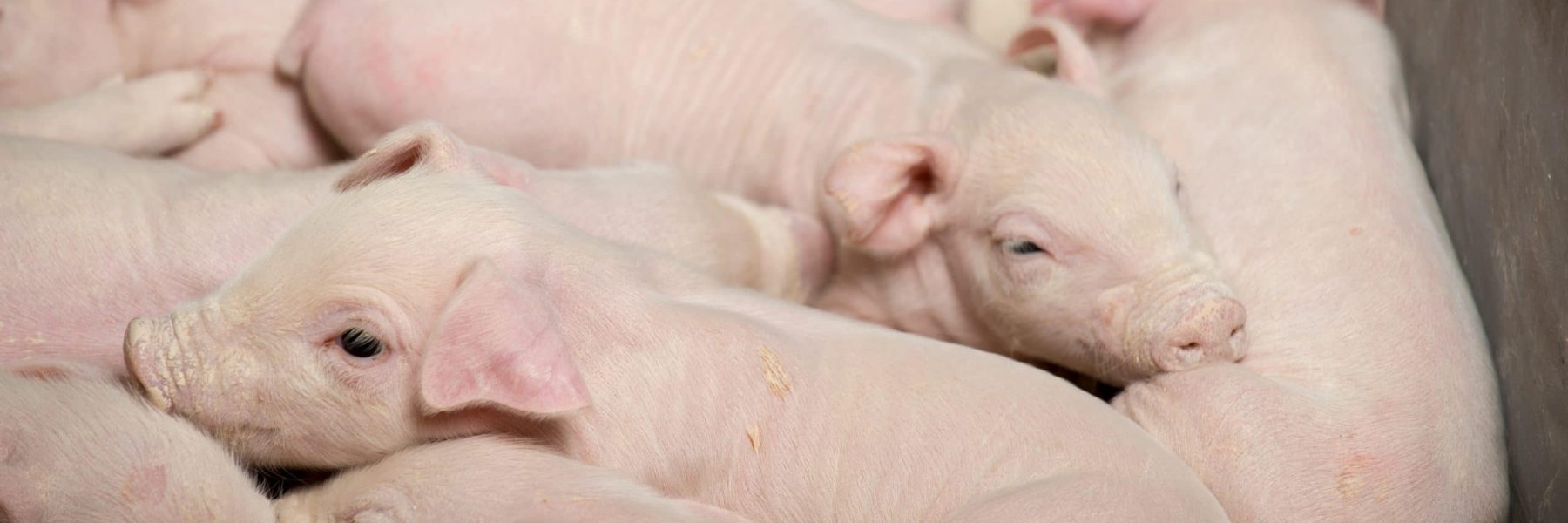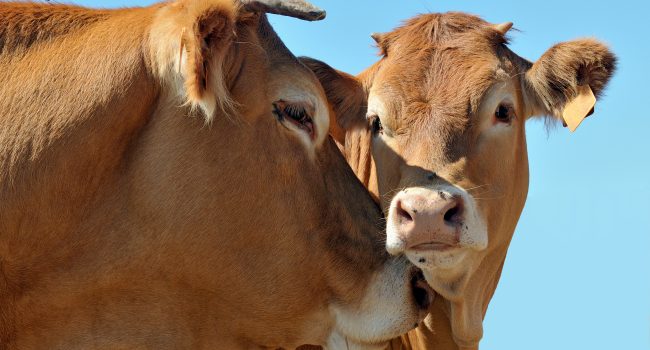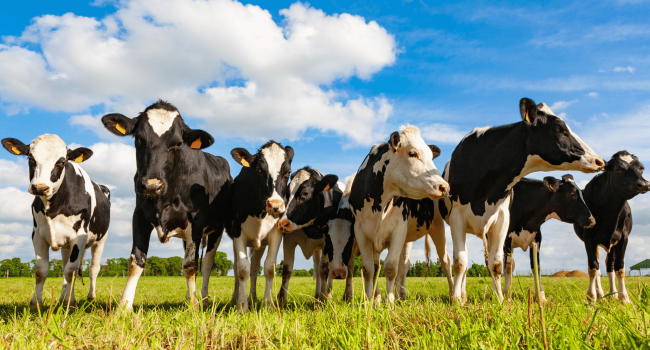The extension on genetic improvements have resulted into a higher sow prolificity and consequently larger litters. Which in reality also goes hand in hand with longer farrowing times, and smaller piglets born. At birth, the neonates passes from a protected intrauterine environment to a challenging extrauterine environment.
The piglet must begin to regulate its body temperature to survive.
Survival rate as key challenge
For neonates, production of heat goes through a repetitive process of muscular contraction. This mechanism provides a considerable supply of warmth, hence consumes the neonates’ energy reserve. The colostrum plays a key role in the piglet´s thermoregulation, immunity, intestinal development and maturation. In summary it is critical for the new piglets to have a quick access to the colostrum in order to retain their energy.
Accompanying hypothermia, the increased attention on mortality levels has been raising over the years due to the elevated appearance of low birth weight which also threatens the neonate
piglets’. Smaller piglets are generally more sensitive.
More susceptible to hypothermia and crushing, the smaller piglets normally requires more attention in order to increase their survival
rate.
The survival of piglets is driven by two main factors; the piglets’ act to obtain the colostrum intake and the environmental factors. Both factors, we shall and can influence. When risk factors are well managed at the start it will benefits during the longer run. A good start shows an increased average daily gain over the whole cycle.
Use of litter conditioner
As part of the solution to help ensuring piglets vitality and support the challenging stages of the animal life cycle, litter conditioners are commonly used. In this context, ADM developed
PURlite, a powdered blend of vegetal and mineral raw materials with absorbent, cleaning and non-irritating properties.
With powerful drying and odor binding effects, PURlite plays a major role in environmental management of animals and their litter.
The litter conditioner will directly support on the critical moments of the neonates and can be directly applied on the piglet straight after birth. By applying it on the piglet, it will contribute to dry
the piglet and thus warming the piglet. As a direct result of the drying, warming and hygiene effect, it provides to the piglets the appropriate conditions to have a quick access to the colostrum, resulting into higher chances of survival.
As well on the healing parts it plays a role, such as a faster healing of the umbilical cord of the piglets. Indirectly another effect of the application methods of PURlite allows an operator to be nearby and may support after drying the piglet to reach the colostrum.
PURlite has naturally cleaning and non-irritating properties, by the usage of plant based aromas. It also has been show to leave a pleasant smell for the animal and operators. The product solely has to be applied onto the animals environment and the animal itself. It does not irritate the animals skin, neither the one of the operator.
Results in field conditions
In order to demonstrate the litter conditioner effect on piglets, trials were conducted. A first trial was set up in France with a control group without PURlite vs trial group with PURlite. The trial
took place from birth to weaning (0 – 28 days) with 3 sows’ batches and their born alive piglets: 23 sows and 336 piglets. Sows breed is large white x landrace and boar semen from large white
x Pietrain.
The product is easy to apply and does not induce process adaptations, as follow :
• On the floor (on carpets, on the nest plate, on the heated plate)
• On the piglets, covering the piglets with PURlite at birth and applying the first 2 days (50g of PURlite per piglet).
Various measurements were implied:
• Weighing piglets at birth, 24h after birth and 48h after birth and at weaning.
• Piglet rectal body temperature at birth, 1h after birth and 24h after birth.
• Indoor temperature/temperature of the heated plate
• Feed quantities distributed to sows and piglets.
• Sanitary status and mortality
In the table 1, we observed a positive result for the PURlite group in terms of mortality rate and also on the crushed piglets numbers.
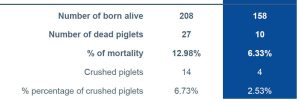
When a comparison was done on the Average Daily Gain (Figure 1) between the PURlite and the control group the result was significant higher in the PURlite group especially in the first 48 hours, which are the critical hours.
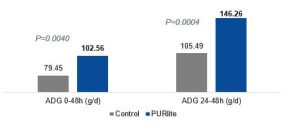
Other results that were conducted were on the temperature drop where piglets within PURlite group lost less rectal T°C than in control group 1h after birth. Finally, when we observed the
results in terms of mortality rate split between light and normal piglets (linked to piglets weight at birth), PURlite participates to better results (Table 2).
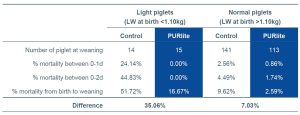
Further trials have been conducted, in Portugal, as well on the bacterial pressure in the living environment and the healing of the umbilical cord (Table 3). We observed that within the usage of PURlite the population of bacteria load decreased (Table 4).

This indicates a better environment for piglet as well as for the sow. In the PURlite group the piglets lost their umbilical cord faster which indicates a faster healing.

Environment challenges not only for the piglets
Controlling bacterial pressure is of importance during the whole period of the swine life cycle. By keeping the environment dry, the bacteria have less moisture to thrive and thus a less comfortable environment to multiple. A dry environment, plays a dominant role in limiting possible infections from open wounds, mastitis, to urinary tract infections (UTI) in sows.
UTI’s are highly prevalent in current pig production systems and cause economic losses due to the predisposition to reproductive failures and shortening of the productive period of sows’, in other words the increase of non-productive days (NPD). Another predisposing factor of higher sow prolificity is the longer farrowing times.
This longer duration will be stressful for the sows. Within the longer farrowing time; support of an operator during farrowing will be desired, yet this might bring extra threats on infections. Additional risks for piglets during these longer farrowing times is the risks of hypoxemia, this may lead to lower viability for the piglets and thus a decrease in immunity. Good farm management and controlling bacterial pressure is crucial to keep the animals safe.
Stress is a process with multifactorial causes (e.g. poor hygiene conditions). Stress may negatively affect the animals health and production. Reduction of possible stress stimuli is another factor to take in account. At different times of the productive cycle the pigs are being regrouped with unfamiliar conspecifics. Alongside with the strongly absorbing capacities, PURlite may support in decreasing negative stimuli when pigs are stressed during re-establishment of the hierarchy through regrouping.
PURlite, the solution to drive hygiene on-farm
A safe environment and welfare remains the key challenge in the swine production. The focus is not only on piglets but also on sows management. PURlite helps to secure the environment for your sows and piglets, participates to the improvement of animal welfare and helps to fully express the genetic potential with a remarkably easy implementation.
